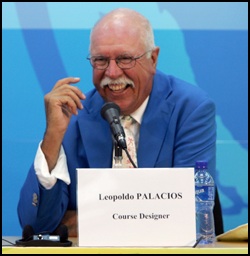By Jackie McFarland
Olaf Petersen, Jr.
You could say that course designing is in his blood. Following in his father’s footsteps, yet making his own distinct tracks, Olaf Petersen Jr. is in that elite group of sought after course designers. Although he has traveled all over the world, his dream is to settle in our own southern California. During one of his visits here designing for Blenheim EquiSports, we had a chance to sit down and learn a bit more about the man behind OP Worldwide.
EqSol: How did you become a course designer? What is your horse history?
OP: My father, Olaf Petersen Sr., started course designing when I was 10 years old. He has course designed all over the world, including the 2004 Olympics in Athens, Greece and the 1988 Olympics in Seoul, Korea. My mother was a dressage rider, so my parents were a strong influence in my horse history. I competed up to the 1.50m level and trained several young horses from four-year-olds to 1.50m. 
My course design career started in 1990 and in 2002 I received my FEI International credentials. I now design about 15-20 weeks per year – there’s not time for more in my current schedule.
EqSol: Your course design mentors?
OP: My father, of course, and Dr. Arno Gego. I also worked with other top designers, including Leopoldo Palacios and Linda Allen. I was fortunate to assist at two Summer Olympic Games, 1996 in Atlanta with Linda Allen and 2004 in Athens with my father.
EqSol: How the course evolves for you…
Outdoor: The 2009 $40,000 Summer Grand Prix at Showpark
OP: Like other course designers, I watch the horses, know the material and the footing. You plan and move the materials to make it work best for the horses.
The quality of the field makes a difference. Last summer when I built at Showpark in August, we had a wide field of 56 riders in the grand prix. A group ready for the 2009/2010 World Cup qualifying season to start, including top West Coast and Mexican riders mixed with young riders moving up at the end of the season.
The footing at Showpark is excellent – we had 250 rounds on the grass that week – that’s a lot. So I tried to make it work for everyone. I knew some would be jumping a tough indoor course the next week at the first CSI-W of the season. So I thought out of 56 riders I would like to have 10-15 clean rounds.
[There were 14 clean. See write up in the EquestriSol August Showpark Edition.]
I will say that I can see a big difference from when I came here three or four years ago. The gap is not so big from east coast to west coast, the level has really come up.
Indoor: The last CSI-W on the West Coast, the $50,000 OC Register Grand Prix
OP: Of course I can’t give away my course plan for this week’s Grand Prix but I do know a few riders here are vying for their final qualifying points. The results will determine the list of west coast riders invited to go to Geneva for the 2010 FEI World Cup in a few weeks. So the course will reflect enough challenge for those competitors but also consider that these horses and riders have already been tested quite a bit throughout the qualifying season.
EqSol: Along with course designing across the world – what else do you do?
OP: I am a partner in a business called The Wegener Group. We produce invoice envelopes for corporate use – banks, insurance companies, etc. We have offices in Germany, Poland & France and soon Vietnam and employ 400 people. I also have a company that produces jumps and other equipment for stables. The web site is www.op-worldwide.com.

EqSol: Your course design goals… and your future plans?
OP: I have had some great experiences in the last two years, from the Mexican Championships in December with Equsport to the NAJYRC in both 2008 and 2009. I have had the opportunity to design for some big events like the Asian Games and several big shows in Europe – and I aspire to build in Aachen and at an Olympic Games. I think every course designer has the Olympic Games as a goal.
I really like coming here to Blenheim and Showpark. Not only is the show management excellent, but also it is my dream to live on the coast in southern California. I love the lifestyle, restaurants, the people, the weather. The Wegener Group is thinking of expanding into the U.S. Maybe then I can make my move…
Thank you Olaf for your time and we hope your California dreams come true.
 How did you become a course designer? What is your horse history?
How did you become a course designer? What is your horse history?